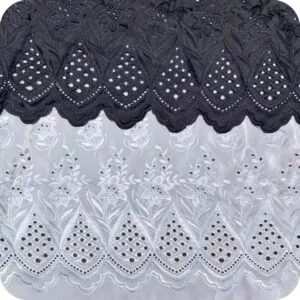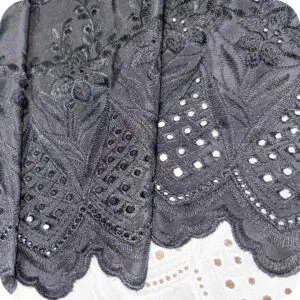
Embroidered fabrics have long been cherished for their intricate patterns, rich textures, and timeless appeal. Combining artistry with craftsmanship, these fabrics continue to evolve with advancements in textile technology while retaining their cultural significance. From high fashion to home decor, embroidered fabrics serve as a symbol of elegance and sophistication. This article explores the benefits and applications of embroidered fabrics, highlighting their versatility and relevance in modern apparel and design.

Understanding Embroidered Fabrics
Embroidered fabric refers to textiles adorned with decorative patterns created through stitching. This process can be done manually or with the use of automated embroidery machines. The stitches often incorporate threads of various colors, along with embellishments like beads, sequins, or metallic elements, to enhance the fabric’s aesthetic appeal.
Modern embroidered fabrics are produced using advanced machinery that ensures precision and consistency. Companies like fabrics-fty.com and textile-fty.com offer a wide range of high-quality embroidered fabrics, catering to the needs of fashion designers, home decorators, and other industries.
Benefits of Embroidered Fabrics
1. Aesthetic Appeal
The most obvious advantage of embroidered fabric is its striking visual appeal. The intricate designs add depth and texture, making garments and accessories stand out. Whether used for formal wear, casual attire, or home decor, embroidered fabrics exude sophistication and artistic flair.
2. Versatility
Embroidered fabrics can be crafted from various base materials such as #CottonFabric, #SilkFabric, #PolyesterFabric, and #NylonFabric. This versatility makes them suitable for a wide range of applications, from lightweight summer dresses to heavy winter coats.
3. Durability
The embroidery process reinforces the base fabric, adding strength and durability. High-quality embroidered textiles maintain their appearance and integrity even after prolonged use, making them a cost-effective choice for long-lasting garments.
4. Customization
One of the standout features of embroidered fabric is its ability to be customized. Designers can create unique patterns tailored to specific needs, making it ideal for personalizing apparel, uniforms, or special event outfits.
5. Cultural and Traditional Significance
Embroidery holds deep cultural value in many regions, symbolizing heritage and tradition. Whether it’s the intricate patterns of Chinese silk embroidery or the bold designs of Indian zari work, embroidered fabrics celebrate cultural diversity and craftsmanship.
6. Breathability
Embroidered patterns often create openings in the fabric, enhancing airflow and making the material more breathable. This property is particularly beneficial in creating summer wear or lightweight garments.
7. Eco-Friendly Options
With the rising demand for #SustainableFabric and #EcoFriendlyFabric, embroidered textiles can be crafted using organic threads, natural dyes, and environmentally conscious production methods. These choices align with modern sustainability goals while preserving the fabric’s luxurious appeal.

Applications of Embroidered Fabrics
The versatility of embroidered fabrics allows them to be used across a wide spectrum of applications. Below are some popular uses in the fashion and textile industries:
1. Formal Wear
Embroidered fabrics are a staple in formal wear, adding sophistication and charm to garments like wedding dresses, evening gowns, and tuxedos. Designers often incorporate #TaffetaFabric or #OrganzaFabric as a base for embroidery, creating ethereal and luxurious attire.
2. Casual Clothing
In casual wear, embroidery adds personality to everyday outfits. T-shirts, jeans, and jackets adorned with embroidered details have become a trend in streetwear fashion, offering a blend of comfort and style.
3. Children’s Clothing
For children’s apparel, embroidered patterns like floral designs, animals, or whimsical motifs add a playful and charming touch. These designs are typically crafted on soft materials such as #KnittedFabric or #FleeceFabric to ensure comfort.
4. Outerwear
Embroidered #SoftshellFabric and #CorduroyFabric are often used for creating jackets, coats, and blazers. These garments offer warmth, durability, and an aesthetic edge, making them a favorite among fashion-forward consumers.
5. Lingerie and Sleepwear
Lace-like embroidery on #SatinFabric or #ChiffonFabric elevates lingerie and sleepwear, combining sensuality with comfort. These intricate details enhance the luxury appeal of intimate apparel.
6. Accessories
From handbags and scarves to hats and belts, embroidered fabrics are frequently used in accessories. The tactile nature of embroidery adds a unique texture that enhances the overall design.
7. Home Decor
Embroidered textiles are also a popular choice in home decor, adding elegance to curtains, cushions, tablecloths, and upholstery. #VelvetFabric and #CanvasFabric are commonly used as the base materials for these decorative items.
8. Sports and Team Apparel
Customization options make embroidered fabrics ideal for creating team uniforms, sports jerseys, and branded apparel. The durability of embroidery ensures that logos and designs remain intact even with frequent use.
9. Cultural and Traditional Attire
Cultural clothing such as saris, kimonos, and traditional robes often feature elaborate embroidery. These garments honor cultural heritage while offering stunning visual appeal.
10. Bridal Wear
Wedding dresses and bridal accessories often rely on intricate embroidery to create a timeless and romantic look. #TwillFabric and #MeshFabric are frequently used for these purposes.
Why Choose Embroidered Fabrics?
The charm of embroidered fabrics lies in their ability to blend beauty with practicality. They offer a unique combination of durability, versatility, and artistic appeal, making them a favored choice for designers and consumers alike. At fabrics-fty.com and textile-fty.com, we provide an extensive range of embroidered fabrics tailored to suit diverse needs. From casual clothing to high-fashion designs, our collection ensures top-tier quality and style.
Fabrics Suitable for Embroidery
Several types of fabrics serve as excellent bases for embroidery. The choice of fabric depends on the intended application and design. Popular options include:
•#JacquardFabric: Perfect for creating intricate patterns with added texture.
•#DenimFabric: A durable base for casual embroidery designs.
•#RayonFabric: Offers a smooth surface for detailed stitching.
•#TerryFabric: Ideal for towel embroidery and other soft textiles.
•#RecycledFabric: Combines sustainability with aesthetic appeal.

Conclusion
Embroidered fabrics represent the perfect fusion of tradition and innovation, catering to the needs of modern consumers while honoring timeless craftsmanship. Their wide range of benefits, from durability to customization, makes them a versatile choice for fashion, home decor, and more. Whether you’re designing a wedding dress, creating branded apparel, or adding a personal touch to everyday clothing, embroidered fabrics offer endless possibilities.
Explore the world of embroidered textiles at fabrics-fty.com and textile-fty.com. Discover how our premium collection can elevate your designs and meet your creative needs.
#EmbroideredFabric #LuxuryTextiles #FashionDesign #CustomApparel #CulturalTextiles #HomeDecorTextiles #EcoFriendlyFabric #HighQualityFabric #DurableTextiles #VersatileFabric
